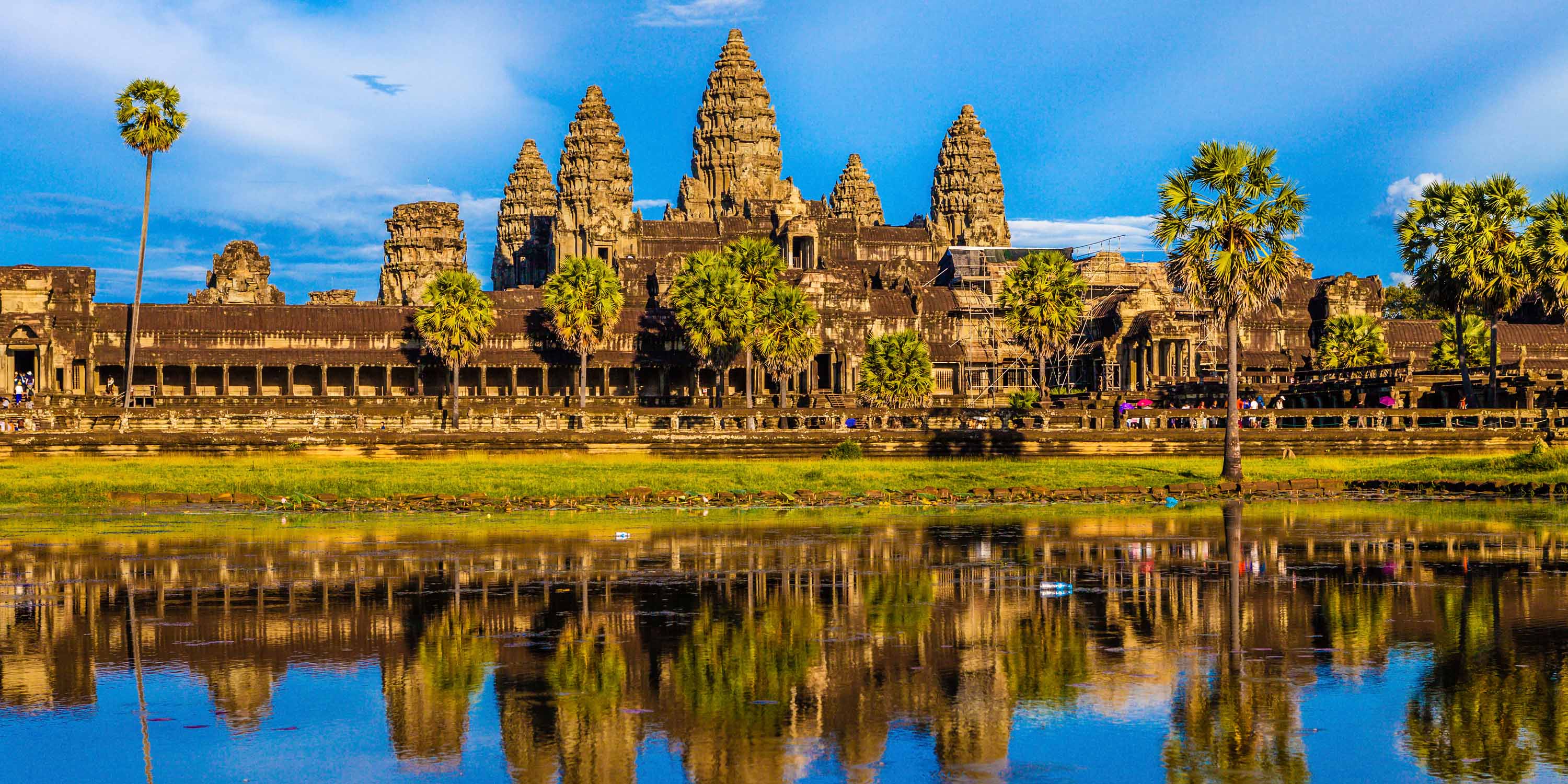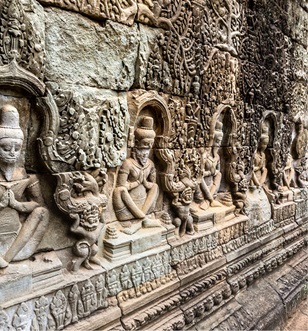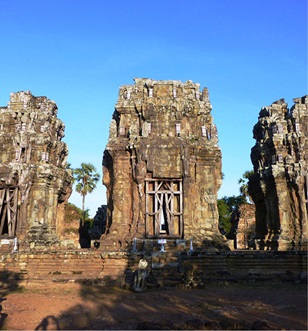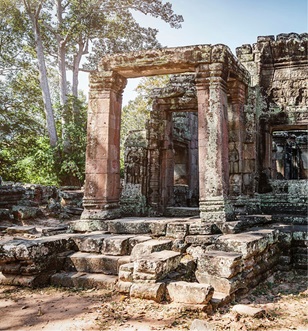Explore vibrant Vietnam & Cambodia by river
The Angkor region boasts the highest concentration of the best-preserved temples in Asia, whilst elsewhere in the country, hidden gems and untouched wonders beckon, recalling dramatic discoveries of bygone eras.
With a wealth of spiritual sites to explore throughout the country, we’ve put together our list of the 10 best temples in Cambodia.
The best temples in Cambodia


A symbol of Cambodian identity and a great source of pride, the temple complex of Angkor Wat is considered the most iconic of the Kingdom's many wonders and one of the best temples in Cambodia.
Constructed in the 12th century by King Suryavarman II, the gigantic temple complex is an earthly representation of Mount Meru, the sacred five-peaked mountain of Hindu cosmology.
Through the intricate stone carvings, the temple's fascinating history unfolds. Originally built as a Hindu temple devoted to Vishnu, Angkor Wat became rededicated as a Buddhist temple in the 14th century. Today, statues of both Buddha and Vishnu are visible across the temple grounds, alongside the celestial Apsara and Devata carvings depicting ethereal and elegant goddesses.
A popular destination at sunrise, the golden rays seep into the detailed stonework of the spires, representing the five mountains of Meru. At this hour, the vast moat surrounding the complex reflects the architecture into the symbolic eternal waters, making for one of the most picturesque spots on earth.
At the ruinous site of Ta Prohm, you'll find the otherworldly standoff between human ingenuity and nature. Here, as the surrounding jungle advances and reclaims the landscape, a vast root system embraces the deteriorating towers of the once-immaculate Buddhist temple.
Myth and stone conquer as a film of lichen covers the bas-relief stonework of meditating monks and temple guardians, and the gigantic roots of the silk-cotton, gold apple, and strangler fig trees prise apart the walls and terraces.
Constructed during the late 12th and early 13th centuries in the local Bayon style, a richly decorated form of Khmer architecture, Ta Prohm served as a monastery and university for Mahayana Buddhists. Following the fall of the Khmer Empire in the 15th century, the temple complex became neglected and eventually abandoned, allowing the encroaching jungle to seize control.
Today, restoration attempts have stabilized the environment, protecting the monument from damages while maintaining the ‘condition of apparent neglect’ that propelled Ta Prohm to fame. The site is one of the most popular in Cambodia. The jungle's mark upon the otherwise well-preserved temple gifts it a unique atmosphere, an ambiance recognized in media and by visitors.
This 10th-century wonder is made of pink sandstone, with its malleability like that of wood, allowing for much more intricate and detailed carvings than the neighboring temples. Nicknamed the ‘jewel of Khmer art’ for its graceful artistry, the name Banteay Srei translates to ‘the Citadel of Women’, with locals claiming that the large hands of men couldn't have achieved such a level of intricate detail.
A much smaller site than many others on this list, Banteay Srei's grandeur lies within its artistry. Commissioned not by a King but by a Brahman, the temple is devoted to the Hindu god, Shiva, a member of the holy trinity (trimurti) of Hinduism.
Once a place of worship and study, the temple is made of sanctuaries and libraries, lavishly decorated and displaying the archetypal, often three-dimensional stonework. Scenes from Hindu scripture and mythology appear across the site, with many of the temple's motifs honoring the tales of Shiva.
A visit to Banteay Srei is a unique experience, as the temple differs from many other Angkorian wonders. In contrast to the magnitude and gravitas of Angkor Wat, this intimate and spiritual setting may be small, though its impact is mighty.
With over 200 12ft high sculpted faces towering amidst the dense jungles of Angkor, the ruins of Bayon are famed for their gentle smiles. A rousing location bordering on the surreal, the serene and smiling faces gaze from their rocky abode to face one of the cardinal directions of the compass.
A statement of architectural ingenuity, the face temple's story is one of emphatic religious sentiment and more than a dash of egotism. Commissioned by Cambodia's highly celebrated and first Buddhist King, Jayavarman VII, the glaring heads of the Bayon temple exude influence and power as they keep watch over Jayavarman's subjects.
Much remains mysterious about the ruins of Bayon, including the name itself; however, it's thought that the temple began life as a political and religious statement celebrating the regional shift from Hinduism to Mahayana Buddhism. Alongside the Buddhist iconography, Bayon's stonework features odes to Jayavarman's rule, with motifs depicting naval victories against the invading peoples of the Champa region.
Credited with introducing the welfare state, the spiritual and psychical needs of the region remained a focus for King Jayavarman VII, as evidenced in the scenes of everyday life carved into the Bayon stonework. Scenes including a chess match, a cockfight, meal preparations, and market sellers grant great insight into the daily life of the era.
Neak Pean is a tiny temple with a profound spiritual history. Believed to represent the mythical lake of Anavatapta, whose waters are said to cure all ailments, the temple's design was for medical purposes, with the pool intending to balance the elements within the bather, curing them of any illness or disease.
Standing on an island at the center of the water: the petit temple is under the protection of two nagas, the mythical half-human and half-cobra semidivine beings of Buddhism, Jainism, and Hinduism. These protective spirits give the temple its name, Neak Pean, ’The Entwined Serpents’.
Enchanting mythical tales are represented in stone across this small site. Where water once flowed from the main pool into the four peripheral pools via ornamental spouts, still visible to this day, you'll find the striking figure of a horse supported by a tangle of human legs. This curious statue depicts the legend of Avalokiteshvara, who protected his shipwrecked followers from attack by transforming himself into a flying horse.
Elsewhere you'll find several Lingam and Yonis, abstract and symbolic representations of Shiva, and his female counterpart, Shakti. These fascinating statuettes juxtapose the intricate and lifelike statues with aniconic and symbolic representations of deities.
Encircled by the verdant jungle foliage, Neak Pean is a spectacular sight and one of the best temples in Cambodia, an excellent location to further explore the country’s mythical and spiritual traditions.
One of the largest temples of Angkor, the site is a maze of vaulted corridors and galleries and was once the home of major spiritual festivities, alongside serving as a center for worship and spiritual education, displaying a true fusion of Buddhist and Hindu spirituality.
Commissioned by the devoutly Buddhist King Jayavarman, Hindu devotees erected additional statues during the reaction of the 13th century. During this time, several depictions of the Buddha were altered, reflecting the idols of Hindu scripture, and today, odes to Buddhism and Hinduism are visible.
A site of many curiosities on the temple grounds, you'll find a two-story, Grecian-style structure, the exact purpose of which remains unknown, and the resemblance to Athenian architecture is striking.
Nearby, you'll find an intricate wall carving depicting the battle of Lanka, the mountaintop Fortress said to have been burnt down by the monkey god, Hanuman. This stirring carving shows the chaos of a contest fought between man and the gods.
Ongoing conservation and restoration efforts ensure that Preah Khan remains a well-preserved site in the region and one of the best temples in Cambodia, with the fascinating amalgamation of styles and influences making the temple an inspiring location to visit.
Built as the state temple for Khmer King Rajendravarman II, this 10th-century construction has some unique architectural features. The temple mount consists of a three-tiered pyramid with the lowest tier surrounded by twelve symmetrical shrines and the uppermost tier carrying five lotus prasats, or towers.
The laterite and brick stonework give Pre Rup a reddish hue, heightened in the glow of early morning and late afternoon sunlight; a beautiful vision as the temple overlooks the surrounding rice fields and vegetation.
Today, much of the site lies ruinous, the combination of building materials failing to stand the test of time. However, the incredibly detailed lintel carvings found on the southwestern tower are uncharacteristically well-preserved and could be said to surpass the technical ability of European masonry during this period.
The site of Pre Rup may not be the grandest of the temples on this list, though its charms are difficult to ignore. The atmospheric beauty and hidden architectural masterworks make it an unorthodox yet worthy inclusion and well worth a visit.
The panoramic views of the Tonle Sap, surrounding villages, and the gentle sight of water buffalo and mountain goats grazing along the hillside are worth the trip alone, and that's before turning to face the wondrous temple.
Much like the neighboring temples, religious mythology plays a crucial role at the site of Phnom Krom. The rocky outcrops are fabled to have been exposed by Hanuman during his hunt for medicines, as documented in the epic poem, Ramayana.
The three temple towers dedicated to Vishnu, Shiva, and Brahman are in a ruinous state, yet the serene and peaceable atmosphere is palpable. Phnom Krom is a popular site at sunset, the warm glow disappearing into the countryside's rice paddies, villages, and lotus fields.
Just a few meters from the monastery, the pool of Sra Srang stands in testament to Jayavarman's import, constructed for the private bathing of the King and his consorts.
Though the precise function of the temple construction remains unknown, many archaeologists and scholars believe Banteay Kdei is a devotion to Jayavarman VII's religious and spiritual teacher.
A key detail shared with Ta Prohm is the temple's condition. Cleared from the jungle overgrowth by conservators in the 1920s, the poor-quality sandstone used in construction has meant that great restoration efforts are required to preserve and restore the temple.
The temple of Banteay Kdei is less traveled than many others on this list, and the lack of crowds paired with the ethereal image of the Sra Srang waters can make it one of the best temples in Cambodia to visit if you’re looking for a calm and tranquil experience.
The crowds are lively, and the dancers feed off the excitement. For an authentic taste of modern Vietnam, dubstep dance battles are not to be missed. However, if the music and dance styles aren’t to your taste, there are still plenty of other ways to enjoy Ho Chi Minh City’s nightlife.
How many temples are in Cambodia?
Discover the Wonders of Cambodia with Emerald Cruises



21 Days
SEASON: 2026/2027Grand Tour of Vietnam & Cambodia
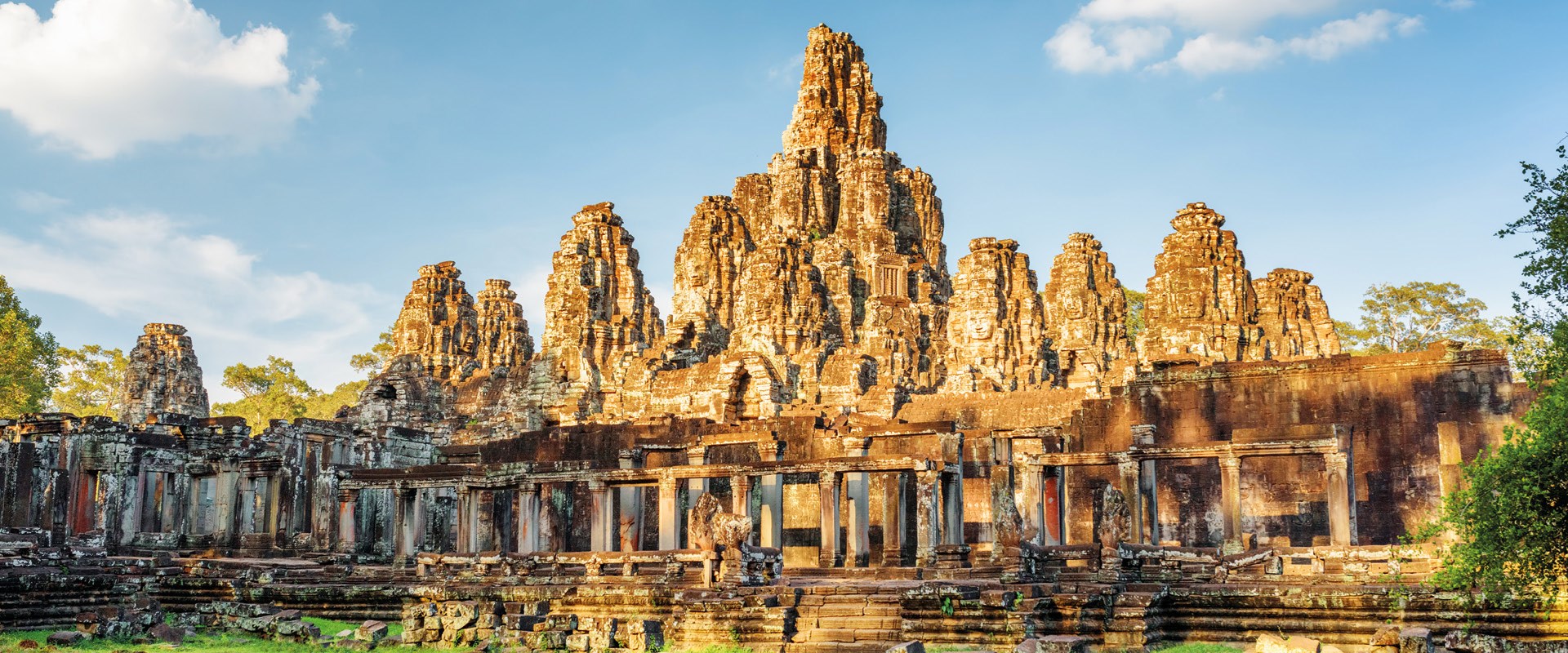
17 Days
SEASON: 2026/2027Treasures & Temples of Vietnam & Cambodia
Explore vibrant Vietnam & Cambodia by river


Start planning your Southeast Asia river cruise
Stay up to date and be inspired
Yes, please keep me updated with the latest special offers, travel inspiration, product updates, and event invites.
